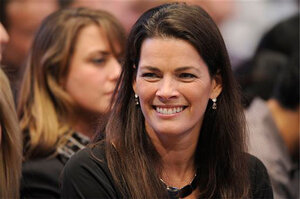Nancy Kerrigan and Tonya Harding: How the scandal changed Olympic skating
Nancy Kerrigan was assaulted 20 years ago today, on Jan. 6, 1994. Experts say the Nancy Kerrigan-Tonya Harding scandal transformed public perception of ice skating, bringing rock star status to a niche sport.

Nancy Kerrigan watches an exhibition tennis match between Pete Sampras and Andre Agassi in New York, Feb. 28, 2011. Monday marks 20 years since Kerrigan was attacked by a man hired by Tonya Harding's ex-husband with the hope of eliminating his former wife's top competition for the US Olympic team.
Henny Ray Abrams/AP/File
Tonya and Nancy.
Mention those names to figure skating fans, or even to those with little interest in the sport, and there's immediate recognition.
"Ah, the whack on the knee."
"Oh, yeah, the 'Why me? Why me?' cries."
"Sure, the scandal."
Well, it's been 20 years since Nancy Kerrigan was clubbed after practice in Detroit by a member of a bumbling goon squad hired by Tonya Harding's ex-husband with the hope of eliminating his former wife's top competition for the US Olympic team. The assault led to a soap opera that practically created tabloid television journalism, taking what had for decades been a niche sport and putting it squarely into the media mainstream.
By the time a recovered Kerrigan and a besieged Harding reached Lillehammer, their saga was front-page news and can't-miss TV.
"Mainstream media was constantly looking for the next juicy story, and they were insatiable and they were intrusive," said Scott Hamilton, the 1984 Olympic champion who pretty much has been the voice of the sport since then. "What I saw and read was alarming. From the New York Times and Washington Post to the National Enquirer, World News and the other tabloids — every member of the media on all levels, no matter their affiliation — they were kind of equal for that moment in pursuing this story.
"It kind of shook me. This was a desperate appetite, a desperate nature. And it kind of dovetailed into the O.J. Simpson stuff later."
Yet the attention figure skating would get from the scandal was a boon for the sport.
Often considered elitist because of its expense, and only something to watch whenever the Winter Olympics rolled around, skating entered an entirely different realm because of Tonya and Nancy.
That surge in popularity lasted for the rest of the 1990s.
"It really expanded skating so much to the point that it was unsustainable," says Byron Allen, who produces the Stars On Ice tour as IMG Worldwide's senior vice president. "What was there for the time was fabulous, and there was so much interest from all angles. Not only for the sport — it did expand the sport — but from the entertainment side, and the scandal side.
"People became household names rapidly with so much exposure ... it developed the industry so quickly and so large. But it created unrealistic expectations."
Suddenly, with the exception of Harding, who would be banned from the sport for life for her role in the attack, skaters were in demand. From the Olympic winners at Lillehammer such as Oksana Baiul, who edged Kerrigan for the gold, to past champions and legends, TV networks couldn't get enough of skating.
Even in non-Olympic years, arenas wanted the two major tours — Stars On Ice and Champions On Ice — along with any other shows featuring folks who could jump, spin and twirl. Both tours were visiting cities across the United States and Canada, and heading off to Europe, Asia, and even to the non-skating continents.
Tom Collins, who owned Champions On Ice for three decades, said business "quadrupled when that incident happened. It put skating in the stratosphere; you couldn't sell enough tickets."
It was, by far, the most lucrative period for skaters in the sport's history. Some of the biggest names were regularly pulling in seven figures.
With skating relegated back to the niche realm, the attention and money has dwindled. Champions On Ice is gone and Stars On Ice has shrunk its schedule.
"Clearly there was an explosion in the sport's popularity and exposure, which was fun to be part of," Kerrigan said.
"I look at where the sport is now and it is too bad that it has swung so far the other way. It tends to reinforce some people's perception that what happened to me was good for skating, and that is just not right. Attacking an opponent for personal gain can never be seen as a good thing."
Kerrigan said it would have been better if a well-organized pro circuit was created during the peak in the sport's popularity.
Hamilton created Stars On Ice in part because he would have been unemployed without it after winning gold at Sarajevo in 1984. He saw the skyrocketing popularity and earning power for skaters following the Tonya-Nancy scandal, but he also saw right through it.
Hamilton knew the positive impact would be fleeting. The International Skating Union opted to invest money into keeping skaters in the Olympic-eligible competitions it controls. So Michelle Kwan, Irina Slutskaya, and Todd Eldredge remained fixtures. That led to plenty of attention for the relatively few competitions, but at the expense of the tours and ice shows that traveled the globe.
"I think the main thing that happened was any time vast wealth comes into anything, it tends to change it," he says. "It changes the image, the mission, what people's roles are and what they should be doing.
"When it is all about competition, the rock star part of the sport no longer exists, and the scale tips so far the wrong way, you don't have anything left to turn to."

